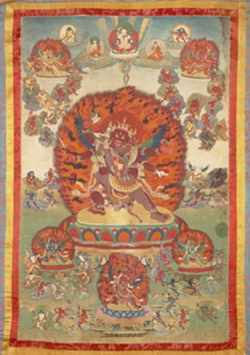Difference between revisions of "The Bardo States"
| Line 1: | Line 1: | ||
[[File:Refuge Bardo B.jpg|thumb|250px|]] | [[File:Refuge Bardo B.jpg|thumb|250px|]] | ||
| − | + | The [[Bardo]] States | |
| − | The Bardo States | ||
| − | |||
| − | + | Central to the [[Tibetan]] concept of after-[[life]] existence is the [[Bardo]] . The word means literally "intermediate state". According to [[Tibetan]] esotericists, steeped as they are in [[Buddhist]] learning, all existence is [[nothing]] but a series of alternating transitional states, or "[[bardos]] ". Waking, [[sleeping]] , [[meditating]] , dying, wandering in the spirt [[world]] , reincarnating; all these are [[bardos]] . Generally however, the term is used to designate the period from [[physical]] [[death]] to [[physical]] [[rebirth]] . And, just as waking existence can be divided into [[bardos]] (such as waking and [[sleeping]] ), so can the afterlife existence. | |
| − | + | Basically then, the [[Bardo]] Thodel describes a distinct sequence of states ([[bardos]] ) through which the individual passes through between [[death]] and [[rebirth]] . There are three distinct [[stages]] , which are as follows: | |
| − | + | The Chikai [[Bardo]] (or hChi-kha Bar-do – a number of [[Tibetan]] letters are [[silent]] ) or Intermediate period of the moment of [[death]] . This includes the process of dying; and the dissolution of the ele-ments ([[earth]] , water, fire, and air) that make up the [[physical body]] . During this period one experiences the "Clear [[Light]] ", one's own innate [[Buddha-nature]] . This is therefore a very favourable moment for the attainment of [[Enlightenment]] and [[liberation]] from the [[wheel]] of [[rebirth]] . | |
| + | The [[Tibetan]] account of the Chikai [[Bardo]] shows striking parallels with the so-called "Near [[Death]] Experience" of people who have died, ex-perienced themselves floating out of their [[bodies]] , and so on, and then been revived. | ||
| − | + | The Chonyid [[Bardo]] (or Chos-nidd Bar-do) or Intermediate period of visions of [[deities]]. This refers to the state where one experiences visions of [[deities]] , [[Heaven]] and [[Hell]] , Judgment, and so on. Modern writers have been struck by the parallels with the psychedelic and psychotic states, and experiences of "astral travelling" and the "astral plane" | |
| + | The [[Sidpa Bardo]] (or Srid-pa'i Bar-do) or Inter-mediate period of [[rebirth]]. During this [[bardo]] the [[consciousness]] descends and chooses a new [[body]] to be born into. ([[Buddhists]] do not accept the existence of a single continuing entity which "reincarnates", and refer instead to the "[[rebirth]] " of the [[consciousness]] -stream in a new [[body]] ). | ||
| − | + | The number of days given in the [[Tibetan Book of the Dead]] – 49 – is obviously [[symbolic]] , although the Tibetans themselves, like all people (including Westerners) who are immersed in a particular [[religious]] [[tradition]] , take it in a literal context. | |
| − | |||
| − | The number of days given in the Tibetan Book of the Dead – 49 – is obviously symbolic, although the Tibetans themselves, like all people (including Westerners) who are immersed in a particular religious tradition, take it in a literal context. | ||
| − | |||
Revision as of 18:52, 11 July 2013
The Bardo States
Central to the Tibetan concept of after-life existence is the Bardo . The word means literally "intermediate state". According to Tibetan esotericists, steeped as they are in Buddhist learning, all existence is nothing but a series of alternating transitional states, or "bardos ". Waking, sleeping , meditating , dying, wandering in the spirt world , reincarnating; all these are bardos . Generally however, the term is used to designate the period from physical death to physical rebirth . And, just as waking existence can be divided into bardos (such as waking and sleeping ), so can the afterlife existence.
Basically then, the Bardo Thodel describes a distinct sequence of states (bardos ) through which the individual passes through between death and rebirth . There are three distinct stages , which are as follows:
The Chikai Bardo (or hChi-kha Bar-do – a number of Tibetan letters are silent ) or Intermediate period of the moment of death . This includes the process of dying; and the dissolution of the ele-ments (earth , water, fire, and air) that make up the physical body . During this period one experiences the "Clear Light ", one's own innate Buddha-nature . This is therefore a very favourable moment for the attainment of Enlightenment and liberation from the wheel of rebirth .
The Tibetan account of the Chikai Bardo shows striking parallels with the so-called "Near Death Experience" of people who have died, ex-perienced themselves floating out of their bodies , and so on, and then been revived.
The Chonyid Bardo (or Chos-nidd Bar-do) or Intermediate period of visions of deities. This refers to the state where one experiences visions of deities , Heaven and Hell , Judgment, and so on. Modern writers have been struck by the parallels with the psychedelic and psychotic states, and experiences of "astral travelling" and the "astral plane"
The Sidpa Bardo (or Srid-pa'i Bar-do) or Inter-mediate period of rebirth. During this bardo the consciousness descends and chooses a new body to be born into. (Buddhists do not accept the existence of a single continuing entity which "reincarnates", and refer instead to the "rebirth " of the consciousness -stream in a new body ).
The number of days given in the Tibetan Book of the Dead – 49 – is obviously symbolic , although the Tibetans themselves, like all people (including Westerners) who are immersed in a particular religious tradition , take it in a literal context.
